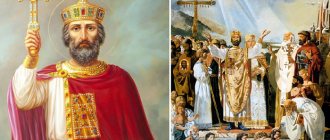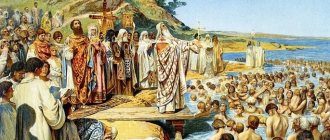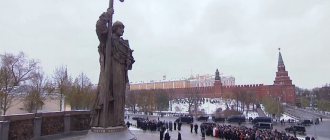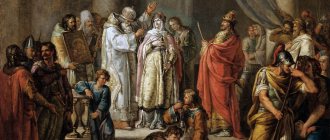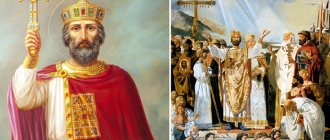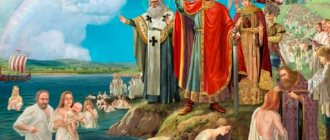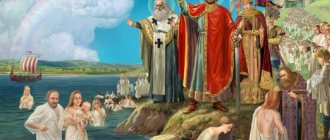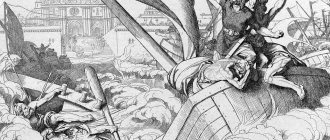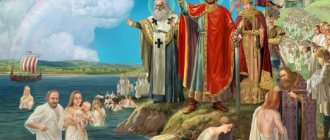Reasons for the need for Christianization
Before moving on to analyzing the consequences of Christianization, it is necessary to find out what were the prerequisites for making such an important decision.
, idolatry was widespread in the territory of Kievan Rus . The many tribes that were part of the state worshiped different deities and adhered to their own religious laws. Sources that have survived to the present day list Perun, Dazhdbog, Khors, Simargl, Yarilo, Mokosh, etc. The worship of some of them involved bloody sacrifices.
Constantly exposed to raids by nomads, the state needed to unite the tribes. Only the powerful force of faith in something united could contribute to this process. Therefore, Vladimir Krasnoe Solnyshko chose the religious “leverage of influence” to strengthen the interrelations of the tribes and strengthen his own power. In pagan times, the prince was just a military leader who could be overthrown or killed.
In 980, Vladimir tried to create a religious pagan center in Kyiv. For this purpose, a huge temple was built, where idols of the six most revered gods were located. But the reform did not bring the desired result: the tribes continued to worship their deities. The adoption of faith in one God became a necessity.
The international situation played an important role in the decision to Christianize Kievan Rus. In order to create and strengthen economic ties with neighboring states, it is necessary to have common ideological and religious views with these countries. And most European countries professed monotheism (belief in one God). There were several directions of monotheism in Europe:
- Christianity (Byzantium, Germany, Danube Bulgaria and Moravia).
- Islam (Volga Bulgaria and the Arab Caliphate).
- Judaism (Khazar Khaganate).
Vadimir understood that if he did not soon establish a single religion on the territory of the state, then Kievan Rus would be fragmented according to religion into several parts, and this could provoke the collapse of the state.
Dynastic marriages with representatives of other countries were of no small importance for expanding territorial borders and strengthening political and economic relations. This was another significant reason for the need for Christianization of Kievan Rus.
Prerequisites for the emergence of a new faith on Russian lands
Prince Vladimir understood that with the scattered pagan tribes of the Slavs, a strong power could not be built . He chose a single religion , which was supposed to cement the union of the Eastern Slavs with a common idea. He doubted for a long time which religion to choose. The chronicles say that representatives of the most powerful religions at that time came to the Russian prince to persuade him to their faith.
Embassies from Muslims from Volga Bulgaria, from Khazar Jews, representatives of the Roman Church and envoys from Byzantium arrived in Kyiv. The prince also sent his ambassadors to see the rituals of religions with their own eyes and see how each religion affected the lives of the local population. After the return of their ambassadors and after a long council of the boyars, it was decided to accept Christianity of the Byzantine rite.
Choice of religion
The ancient Rus became acquainted with Christianity long before the reign of Vladimir. Back in the 9th century. The head of the Church of Constantinople, Patriarch Photius, sent missionaries to warlike states in order to expand the borders of Byzantine influence. Thus Moravia and Bulgaria were Christianized. In 860, Kievan Rus attacked Constantinople. Therefore, the patriarch considered it necessary to send Christian preachers to the lands of the Russians.
The Tale of Bygone Years testifies that thanks to missionary work, princes Askold and Dir, as well as some boyars, were baptized . This small baptism in history is called Askoldov or Photius. The next, but already officially, Princess Olga was baptized in 957 and sought to ensure that Byzantium perceived Kievan Rus not as a barbarian state, but as an equal power.
Having made the decision to be baptized, Vladimir hesitated in choosing his religion. Since the bordering states professed both Islam and Judaism, the prince decided to listen to all religious representatives and, based on an analysis of their beliefs, make a choice. Historians call this event the “Test of Faith.”
In 986, missionaries from the Volga Bulgars arrived to Prince Vladimir. They preach Islam to the prince; after listening to the ambassadors, Vladimir renounces such faith. The reason for the refusal was the ban on drinking alcohol and eating pork. At that time, not a single negotiation was complete without drinking and tables laden with food. But Islam allowed polygamy, which attracted the loving prince (he had about 800 concubines in different parts of the country). After weighing the pros and cons, Vladimir abandoned Islam.
The next visitors were Germans, sent by the Pope. But at that time relations with Germany were strained, so Vladimir, without thinking for a long time, sent the ambassadors home. After the Germans, the Khazars came to an audience. But this nation was going through hard times: recently the Khazar Kaganate was defeated by Vladimir’s father Svyatoslav. And since the prince pursued primarily political and economic goals, the Khazars settled in other states were of no interest to him. The prince also abandoned Judaism.
The last to arrive to the ruler of Rus' was an ambassador from Byzantium. He spoke about God, his son Jesus Christ and the Holy Spirit, and spoke about the Gospel. And Vladimir made a preliminary decision in favor of Christianity.
Later, Russian ambassadors were sent to religious centers and attended the services as observers. As a result of their trip, a firm decision was made to accept the Christian faith.
The Negative Impact of Adopting Christianity
It is important to note that the main disadvantages did not appear immediately. So here they are:
- First of all, the fundamental disadvantage was the distancing from Latin . And if for the first few centuries this did not create critical difficulties, then by the time of the rapid development of science in Europe, ignorance of the language of the Catholic Church resulted in a rather serious lag in the scientific field.
- The very formation of Christianity on the territory of Russia took place in a rather bloody manner . There were several reasons for this, the main ones are given below: Initially, representatives of the aristocracy, which, in essence, was the military class in early feudal Rus', were baptized. As a result, those who did not agree to voluntary baptism were dealt with as was more customary - instilling their opinion with fire and sword.
- Despite the conversion to a new faith, the old orders and views have not gone away. In fact, under the conditions of pagan Rus', Christianity went through the vivisection of popular awareness and moved away from its original state very significantly.
The course of the baptism of Rus'
In 987, Constantinople asked for military assistance from Rus' to eliminate the rebellion that broke out under the leadership of Bardas Phocas. Vladimir agreed on the condition that Byzantium would allow him to marry the sister of Emperors Vasily and Constantine, Princess Anna. The emperors, in turn, put forward a demand that the prince accept the Christian faith. And in 987, Vladimir the Red Sun was baptized in the Church of Constantinople.
Upon the arrival of the Grand Duke, the first to be baptized were his relatives and those close to the court: servants, governors, advisers. The temple, which was built in honor of the idol gods, was destroyed and burned along with the statues. And the main deity of Perun was demonstratively tied to the tail of a horse and sent around towns and villages.
Then the Grand Duke gave the order for a general meeting of the residents of Kyiv on the banks of the Dnieper. People entered the water and were baptized in the likeness of Christ by Byzantine priests sent on this mission by the Patriarch of the Church of Constantinople.
But not all tribes of Kievan Rus agreed to abandon paganism. Novgorod desperately resisted. In suppressing the popular uprising, the main role was played by Vladimir’s uncle on his mother’s side, Dobrynya Nikitich. It is he who we know from numerous legends and epics of Ancient Rus'.
Although Rus' was officially baptized in 988, remnants of paganism persisted among the population for a very long time. Avid adherents of paganism underground agitated the people for the renunciation of the one God. To weaken their influence, biblical ones were attached to many pagan holidays. For example, the day of worship of the summer sun god Kupala was designated as the day of remembrance of John the Baptist. Gradually, people got used to it and began to treat Ivan Kupala as a Christian holiday.
Methods of carrying out religious reform and resistance to it
As already mentioned, the Russian population did not experience any special desire to become Christians. Therefore, the prince had to implement his plan by force.
The chronicle (despite its Christian character) states that the people of Kiev were forced into the Dnieper for baptism, and many people drowned. Vladimir began the process with large cities, but, for example, Novgorod showed desperate resistance to the expansion of the new religion. Written sources contain references to how Dobrynya (the prince’s maternal uncle and his teacher) “baptized Rus' with fire” - the prince’s warriors burned the temples along with the wise men and other supporters of the faith of their ancestors defending them.
Major uprisings against forced Christianization were noted after Vladimir's death. They took place in Murom, Yaroslavl, Rostov even during the time of the heirs of Yaroslav the Wise. The last major pagan uprising in Novgorod occurred in 1070, and Rostov was finally baptized in 1078. In many ways, these uprisings revealed a general dissatisfaction with the Kyiv dictatorship rather than a desire to necessarily defend the pagan faith, although this factor also took place - as a reaction to the mass vandalism of Christianizers who desecrated temples and killed the Magi.
Already Vladimir began to create a Christian infrastructure in Rus' - to build churches, establish church administration, train his own priests (before that they were the Byzantines) and Christian literature. However, the structure of the Russian church was completely formed under Yaroslav the Wise. At the same time, the transformation of the church as a structure into a large feudal landowner and authority took place.
Consequences of Christianity
The consequences of the adoption of Christianity in Rus' can be divided into two categories: positive and negative. It is necessary to first cite the positive changes in the life of the state, since there were much more of them:
- Strengthening the power of the ruler of the state. Religion taught people humility and obedience, and those in power - responsibility for the fate of their subordinates. Faith in one God contributed to the unity of the Russian people.
- Creation of the Church Charter. Approval of the church and princely courts.
- Improving the moral foundations of society. Blood sacrifices are prohibited. The Bible teaches people to be just and merciful. Vladimir showed by his example what changes happen to a person if he believes in one God. The prince forever renounced polygamy, was engaged in the construction of hospitals and shelters for the poor and homeless, and on holidays he distributed food and money to everyone. For all the listed benefits, Prince Vladimir was canonized by the church.
- The state has acquired the opportunity to fully interact with other powers. Baptism had a beneficial effect on strengthening trade and economic relations.
- It was easy for the princes who followed Vladimir to establish external political connections with the help of dynastic marriages.
- A huge leap in the development of architecture and painting. Temples were no longer built from wood, but from brick. The Russians learned to make domes and decorate cathedrals and churches with them. The Cathedral of St. Sophia, the Kiev Pechersk Lavra, etc. were built. Frescoes, mosaics, icon painting are all Byzantine heritage.
- The emergence of writing. Thanks to Cyril and Methodius, Rus' became acquainted with the Cyrillic and Glagolitic alphabet. Schools were created at the monasteries, where they taught writing to everyone. Bibles and lives of saints were copied there, and the first chronicles were composed.
- The state gained access to the study of cultural and material values of the ancient period.
What are the negative effects of Christianity? In the 15th century, the fall of Byzantium occurred, and the Kiev state found itself in “religious isolation,” which lasted until the 18th century.
Having briefly studied the causes and consequences of the baptism of Rus', we can conclude: the 10th century became the most intense period of progressive changes in the history of the great state.
Christianity in the XI-XII centuries.
The main directions of Christianization of the state and society, outlined during the baptism of Rus', were continued in the 11th-12th centuries. The diocesan structure became more fragmented, the number of dioceses increased to twelve. The development of the parish system during this period is difficult to judge due to the lack of data; it probably followed the development of state administration. structures, since the parish church was usually located in the administrative center (pogost). Church-state interaction in the field of justice was improved. The growing needs for liturgical books were met by scriptoria operating at large monasteries and, probably, at episcopal sees. All this resulted in a more active Christianization of the rural population. The latest information about pagan uprisings in large cities (Novgorod, Rostov, Yaroslavl) dates back to the 1070s. From this time on, paganism as a social factor is no longer traceable.
How did the baptism ceremony take place?
Before introducing Orthodoxy in Rus', Vladimir Svyatoslavich himself was baptized in Cherones. Here the prince was given the name Vasily. Having become a Christian, he married Anna of Byzantium, sister of the Emperor of Constantinople. After this, the ruler of Ancient Rus' completely abandoned the pagan way of life. Vladimir delved into the study of the Holy Scriptures, ordered to build churches and monasteries according to the Orthodox model, and to burn old idols.
The date when the prince began to baptize Rus' was the summer of 988. All residents of Kyiv were the first to accept Christianity. The historical event took place in one of the tributaries of the Dnieper (Pochaina) with the participation of Constantinople priests. Then Orthodoxy spread to other territories. The process of Christianization was quite successful, but in some cases the pagans showed fierce resistance. The residents of Novgorod were the most persistent in rejecting the Orthodox faith. During armed clashes, all uprisings were suppressed by the princely troops, led by Dobrynya Nikitich. Thus, the entire people were gradually baptized according to the Byzantine rite, and Christianity was firmly established on Russian soil.
Baptism of Prince Vladimir and the people of Kiev
Orthodox priests also arrived from the Greek possessions with the prince to the capital. Missionaries carried the light of Christianity, preaching through the streets of Kyiv. Their activities were accompanied by active actions on the part of the government. First of all, Vladimir renounced his pagan past by releasing his concubines. Now he was married before God along with Anna. The prince baptized his children in front of everyone, and then set about eradicating traces of the pagan reformation in the capital city. The Great Vladimir Temple was destroyed, wooden idols were burned or dragged to the Dnieper, dumped into the water.
It is noteworthy that in historical circles there is still debate about which year should be considered the date of Vladimir’s baptism: 987 or 988. The Tale of Bygone Years is inclined towards the second option, but there is evidence that the prince came to Christianity a couple of years earlier. It is also interesting that in Greek literature of that time no one pays close attention to the Enlightenment of Rus'. The Byzantines, who sent their ambassadors to Kyiv in the middle of the ninth century, considered the date of baptism to be 860. For them, Vladimir’s reforms are just a natural development of events that happened a hundred years ago.
When Kyiv was cleared of traces of pagan religion, the prince personally toured the entire city. He called on every Kievite (slave or master, rich or poor) to come to the Dnieper. Those who dared to disobey were declared enemies of Vladimir in absentia. The ruler's high authority among the people of Kiev contributed to the strict execution of the prince's decree. No one dared to stay at home. The exact day on which the baptism of the waters of the Dnieper took place is not indicated in the chronicles, but it is traditionally believed that this happened at the end of July.
Term and concept
In a historical sense, Epiphany was primarily a political event. Traditionally, this term is understood as the process of establishing a single state religion throughout the entire territory of the lands subject to Vladimir. He united the principalities and fiefs into a single Rus'. The monotheistic way of belief helped Vladimir to gather all power into his own hands under the auspices of the fact that where there is one God, there is one prince.
For the first time, the concept familiar to us was mentioned in the famous “Tale of Bygone Years.” There, the famous events of 988 were called “the baptism of the Russian land.” Later, along with this term, historians of the Russian Empire used the concept of “baptism of Russia”, “baptism of the Slavs”. This is exactly the option that Nikolai Karamzin proposed in his works - the first who managed to combine information from disparate sources into a single monumental work on the history of Russian lands.
In addition, today in historical texts one can find the following concepts: “the introduction of Christianity”, “the second religious reform of Vladimir the Great”. They are all interchangeable. But only “The Baptism of Rus'” has become so widespread in ordinary speech, because there is no more capacious and understandable designation of accomplished processes.
Workbook on the history of Russia. Artasov 6th grade. Paragraph 6
Paragraph 6. Our Motherland - Russia - Workbook on the history of Russia. Artasov 6th grade
- GDZ for a textbook on the history of Russia. Arsentiev. 6th grade part 1
- GDZ for a textbook on the history of Russia. Arsentiev. 6th grade part 2
- GDZ for contour maps on the history of Russia. Torop. 6th grade
REIGN OF PRINCE VLADIMIR. BAPTISM OF Rus'
Task 1. Match the statement with the name of the prince to whom it belongs.
| Prince | Statement |
| 1) Oleg 2) Igor 3) Svyatoslav 4) Vladimir | A) I don’t like staying in Kyiv, I want to live in Pereyaslavets on the Danube - there is the middle of my land. B) Kyiv will be the mother of Russian cities. B) I am baptized, for I have already tested your law and I love your faith... D) Go home with the tribute, and I will return. |
Answer:
- Oleg - B)
- Igor - G)
- Svyatoslav - A)
- Vladimir - B)
Task 2. Study the illustrations in the textbook (pp. 52-53) and match them with the text of the textbook. You will notice that the illustrations contain additional information that is not reflected in the text. Provide this information for each illustration. In your opinion, does the information presented in the illustrations always correspond to historical reality? Justify your answer.
Judging by historical documents, the townspeople did not approve of the overthrow of pagan idols; they were horrified because they feared the wrath of the gods for such treatment of idols. And the picture shows that the townspeople themselves are overthrowing the idol of Perun and this is being done almost by children, which in reality could not have happened.
The people of Kiev took off their shoes and entered the river, and did not undress completely, as shown in the picture. Those who hesitated were driven into the water by the warriors, and they are not visible in the picture at all, like Prince Vladimir and Princess Anna, who stood on the carpet and looked at the baptismal ceremony.
Task 3. Fill in the blanks in the diagram “Reasons for the adoption of Christianity by Russia.”
Task 4. Fill out the table “The significance of the adoption of Christianity for Rus'.”
The significance of the adoption of Christianity for Rus'
| Political | Strengthened the power of the prince and united the Slavic tribes. |
| International | Rus' stood on par with the largest state formations of that time and acquired a strong ally in the person of co-religionists in Byzantium. |
| Moral | It changed the life and character of the inhabitants of Rus'. Eliminated cruel barbaric customs. Contributed to the development of culture and the development of education. |
| Spiritual | Strengthened marriage bonds. It had a huge impact on the picture of the world and the system of ideas of people of that time. |
Task 5. Calculate how many years passed from the adoption of Christianity by Princess Olga to the Baptism of Rus'.
From the time Princess Olga adopted Christianity until the Baptism of Rus', 33 years passed.
Task 6. Read an excerpt from the work of the Russian historian S.M. Solovyov and answer the question.
The main feature of Vladimir’s activities is the defense of the Russian land, in the constant struggle against the steppe barbarians. Svyatoslav deserved the reproach that he left his own for a foreign land, which was almost captured by the barbarians. Vladimir, on the contrary, always stood on guard against these barbarians and set up a guard line from a number of towns or fortifications along rivers close to the steppe...
Do you agree with S.M. Solovyov’s assessment of the military activities of Prince Vladimir? Justify your opinion.
Yes, I agree with S.M. Solovyov’s assessment of military activity. The creation of several lines of fortifications and fortresses on the southern border and the attraction of the best warriors to guard the borders of Rus' can probably be considered the main military achievement of Prince Vladimir.
- GDZ for a workbook on the history of Russia. Artasov. 6th grade
- GDZ for a textbook on the history of Russia. Arsentiev. 6th grade part 1
- GDZ for a textbook on the history of Russia. Arsentiev. 6th grade part 2
- GDZ for contour maps on the history of Russia. Torop. 6th grade
